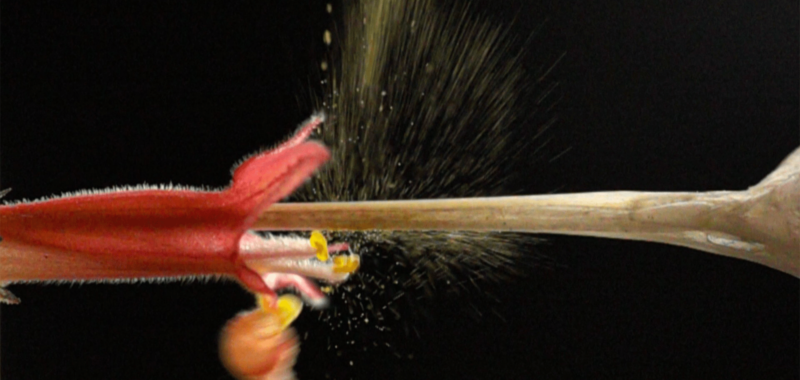Pollination can be a pretty cut-throat process in the plant kingdom. A team of scientists from South Africa and Brazil found that rival plants may compete with one another for space on pollinators. The match-up then influences whose pollen makes it to the next flower and whose does not. The findings are detailed in a study recently published in The American Naturalist.
Over time, some animals and insects have evolved complex structures on their penises that are believed to remove the sperm of rival males from the reproductive tracts of females before they deposit their own.

Pollen grains marked with quantum dots on the bill of a hummingbird (skull). This is being viewed under a UV light source. The grains were placed by us in the bill and counted (only the grains between the two pencil marks). This bill was then inserted into a flower–after the flower exploded, we re-counted the marked grains to see how many the explosion removed. CREDIT: Daniela Cristina de Cario Calaça, César Augusto Arvelos, and Carlos Andres Matallana Puerto
VIDEO: Pollen grains marked with quantum dots on the bill of a hummingbird (skull). This is being viewed under a UV light source. The grains were placed by us in the bill and counted (only the grains between the two pencil marks). This bill was then inserted into a flower–after the flower exploded, we re-counted the marked grains to see how many the explosion removed. CREDIT: Daniela Cristina de Cario Calaça, César Augusto Arvelos, and Carlos Andres Matallana Puerto
Unlike animal mating, plant reproduction does not involve direct contact between flowers. To compete with other male flora, the manipulation of pollen–which carries plant sperm–must occur before the pollen reaches another flower while riding on the bodies of arriving pollinators such as moths, bees, or butterflies. Additionally, roughly 94 percent of plants have both male and female reproductive organs. To avoid self-pollination, individual flowers will often go through a male phase first and then a female phase.
The team behind the study believes that plants can manipulate where and how much pollen is placed on the bodies of pollinators. Plants may have also developed strategies more similar to sperm manipulation in animals to do this.
[Related: Butterflies and moths suck up pollen with static electricity.]
To learn more, researchers studied Hypenea macrantha, a red perennial flower that is endemic to Brazil. In the lab, they set up an experimental simulation and used slow motion video to record the plant’s strategic process. The flower uses a catapult-like mechanism to remove the pollen of rival flowers from the bill of a hummingbird skull and securely placing its own pollen on the same spot.
This mechanism called explosive pollen placement is not entirely unknown in the plant kingdom. The white mulberry has the fastest known movement in both the plant and animal kingdom. The pollen catapult mechanism can exceed 380 miles-per-hour (170 meters per second).

However, this study provides some empirical evidence how effective explosive pollen placement is. To collect this data, the team labeled the pollen removed by the explosion with quantum dots and analyzed their slow motion video. Hypenea macrantha’s pollen travels at 2.62 meters per second after it is released. By comparison, Olympian Usain Bolt runs roughly four times faster at 10.44 meters per second.
According to the team, their findings contain evidence for this idea of competitive pollen removal in plants. Competition between male plants may have also contributed to the evolution of this trait.
“Flowers visited by hummingbirds deposit their pollen on the hummingbird bills, but there is very little place for the pollen to be deposited,” Bruce Anderson, a study co-author and evolutionary biologist at Stellenbosch University in South Africa, said in a statement. “Flowers have evolved a catapult mechanism where pollen is shot at the bill of the hummingbird. The force of the ballistic grains dislodges previously deposited grains from rival plants allowing the flower to place its own grains onto a cleaner bill, thus increasing its chances of reproductive success.”

The plants could be competing with one another in some previously unknown ways. Two flowers like Hypenea macrantha generally do not interact when mating occurs, which makes it difficult for the flowers to manipulate the way that some other plants and animals can. However, the gamete manipulation may actually take place on a pollinator arriving at a flower and not on the leaves or petals of other flowers.
If a pollinator like a speedy hummingbird arrives at a flower covered in rival pollen from previously visited plants, the flower may have a tough time placing its own pollen on the hummingbird since it is covered in the grains of a rival plant. Even if it can get some pollen on the hummingbird, its chances of reproductive success may be quite low since it has to compete with these rival pollen grains to access the ovules of the next flower the bird visits.
[Related: Stressed bees are pessimistic pollinators.]
“So, what can a flower do? Like animals with penis adornments, it can evolve strategies to clean the rival grains from pollinators before placing their own grains,” said Anderson.
Previously, scientists believed that floral explosion was primarily an aid in getting pollen grains on pollinators. It was also theorized as a way to startle them into flying away and onto new plants and spreading the pollen over a larger distance.
“Our data suggest, however, that this mechanism may actually displace pollen from previous flowers, enhancing male reproductive success by increasing competition for space on the pollinators’ bodies,” study co-author and Federal University of Uberlândia in Brazil botanist Vinícius Brito said in a statement.

